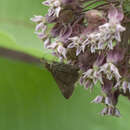North American Ecology (US and Canada)
provided by North American Butterfly Knowledge Network
Euphyes vestris is a year round resident across the eastern United States and southeastern Canada to Alberta, and is also resident in a patchy distribution of separate populations across the western United States (Scott 1986). Habitats are moist areas and open woods. Host plants are sedges, largely restricted to one genus, Carex (Cyperaceae). Eggs are laid on the host plant singly. Individuals overwinter as third instar larvae. There is a variable number of flights each year depending on latitude, with one flight, mainly July1-July 31 in the northern and western part of the range and June 1-June 30 in California; two flights in Virginia-Montana and Texas, between May 1- Sept. 30, and multiple flights in Florida between March 1- Dec. 31(Scott 1986).
Behavior
provided by North American Butterfly Knowledge Network
Adults feed on flower nectar, mud and dung. Males perch for females (Scott, 1986).
Conservation Status
provided by University of Alberta Museums
Only one known occurence in Alberta; more field work needed to establish this species' prevalence.
- license
- cc-by-nc
- copyright
- University of Alberta Museums
Cyclicity
provided by University of Alberta Museums
The only Alberta record is for 20 July (Bird 2001). June 20 to Aug 10 in Saskatchewan (Hooper 1973).
- license
- cc-by-nc
- copyright
- University of Alberta Museums
Distribution
provided by University of Alberta Museums
The Dun Skipper is common and widespread in eastern North America, ranging west to central Alberta. There are several disjunct west coast populations ranging from southern California to southwestern B.C. (Opler 1999). This species is currently known from only one Alberta locality, and further colonies should be sought in the aspen parkland in the central and east-central part of the province.
- license
- cc-by-nc
- copyright
- University of Alberta Museums
General Description
provided by University of Alberta Museums
The Dun Skipper is appropriately named; males are a uniform, dark brown colour, with the black dash on the forewing upperside being the only distinguishable mark. Females have several pale spots near the forewing apex. Similar to Amblyscirtes oslari, which has a grey cast to the hindwing underside (sometimes forming a faint banded pattern), and is smaller in size. Habitat and distribution also serve to separate these two species, since vestris is known only from the aspen parkland, whereas oslari is a species of the southern short-grass prairie. Only subspecies metacomet occurs in our area according to Layberry et al. (1998).
- license
- cc-by-nc
- copyright
- University of Alberta Museums
Habitat
provided by University of Alberta Museums
Grassy woodland openings in the aspen parkland.
- license
- cc-by-nc
- copyright
- University of Alberta Museums
Life Cycle
provided by University of Alberta Museums
Not known for Alberta populations. The eggs of eastern populations are green, and mature larvae are green with fine white lines, with a light-banded, brown and black head (Heitzman 1965).
- license
- cc-by-nc
- copyright
- University of Alberta Museums
Trophic Strategy
provided by University of Alberta Museums
No data available for Alberta populations. Elsewhere, larval hosptlants include the following sedges: Cyperus esculenta (Heitzman 1965), Carex lacustris, C. spissa, C. gracilima (Layberry et al. 1998) in eastern North America, and Carex heliophila in the 'west' (Layberry et al. 1998). Eggs are laid on nut-grass sedge (Cyperus spp.) in Michigan (Nielsen 1999).
- license
- cc-by-nc
- copyright
- University of Alberta Museums
Euphyes vestris
provided by wikipedia EN
Euphyes vestris, the dun skipper, sedge witch or dun sedge skipper, is a species of butterfly of the family Hesperiidae. It is found in North America from Nova Scotia west across southern Canada to southern Alberta, south to Florida, the Gulf Coast and eastern Texas. There are disjunct populations in the High Plains and Rocky Mountains and along the Pacific Coast.
The wingspan is 29–35 mm.[3] Adults are on wing in July in one generation per year.[4] They feed on the nectar from white, pink and purple flowers, including Asclepias syriaca, Vicia americana, Prunella, Mentha × piperita, Apocynum, Ceanothus americanus and Echium vulgare.
The larvae feed on various sedges, including Cyperus esculentus and Carex heliophila.
Subspecies
-
Euphyes vestris vestris (California)
-
Euphyes vestris metacomet (Harris, 1862) (from Alberta east through the southern parts of Saskatchewan, Manitoba, Ontario, Quebec and New Brunswick, southeast through Montana, South Dakota, Kansas, Missouri, Arkansas, Mississippi and Louisiana, and eastward to the Atlantic coast)
-
Euphyes vestris kiowah (Reakirt, 1866)
-
Euphyes vestris harbisoni Brown & McGuire, 1983 (California)
References

- license
- cc-by-sa-3.0
- copyright
- Wikipedia authors and editors
Euphyes vestris: Brief Summary
provided by wikipedia EN
Euphyes vestris, the dun skipper, sedge witch or dun sedge skipper, is a species of butterfly of the family Hesperiidae. It is found in North America from Nova Scotia west across southern Canada to southern Alberta, south to Florida, the Gulf Coast and eastern Texas. There are disjunct populations in the High Plains and Rocky Mountains and along the Pacific Coast.
The wingspan is 29–35 mm. Adults are on wing in July in one generation per year. They feed on the nectar from white, pink and purple flowers, including Asclepias syriaca, Vicia americana, Prunella, Mentha × piperita, Apocynum, Ceanothus americanus and Echium vulgare.
The larvae feed on various sedges, including Cyperus esculentus and Carex heliophila.
- license
- cc-by-sa-3.0
- copyright
- Wikipedia authors and editors

